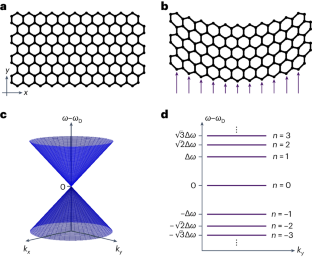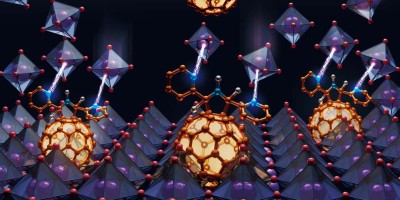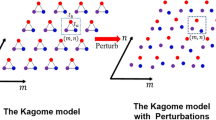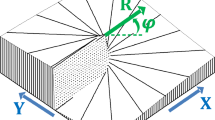Abstract
When electrons are confined to a two-dimensional plane and are subjected to an out-of-plane magnetic field, they move in circular cyclotron orbits as a result of the Lorentz force. In the quantum domain, this cyclotron motion is quantized, and as a consequence, the energy spectrum of the electrons splits into discrete, highly degenerate states called Landau levels. These flat bands are the origin of the integer and fractional quantum Hall effects1,2. Although photons do not experience the Lorentz force because they do not carry charge, they can be made to experience ‘pseudomagnetic fields’3,4 as a result of periodicity-breaking strain. In this work, we experimentally observe photonic Landau levels that arise due to a strain-induced pseudomagnetic field in a silicon photonic crystal slab. The Landau levels are dispersive (that is, they are not flat bands) due to the distortion of the unit cell by the strain. We employ an additional strain of a different form that induces a pseudoelectric potential to flatten them. By acting akin to cavities that are delocalized across space, flat bands such as these have the potential to strongly enhance light–matter interaction as a result of the photonic structure. The analytical framework that we develop here for understanding the effects of inhomogeneous strain in photonic crystals via gauge fields can help to guide the design of multiscale non-periodic photonic structures.





Similar content being viewed by others
Data availability
Data are available from the corresponding author upon reasonable request.
References
Tsui, D. C., Stormer, H. L. & Gossard, A. C. Two-dimensional magnetotransport in the extreme quantum limit. Phys. Rev. Lett. 48, 1559 (1982).
Klitzing, K., Dorda, G. & Pepper, M. New method for high-accuracy determination of the fine-structure constant based on quantized Hall resistance. Phys. Rev. Lett. 45, 494 (1980).
Guinea, F., Katsnelson, M. I. & Geim, A. Energy gaps and a zero-field quantum Hall effect in graphene by strain engineering. Nat. Phys. 6, 30–33 (2010).
Rechtsman, M. C. et al. Strain-induced pseudomagnetic field and photonic Landau levels in dielectric structures. Nat. Photon. 7, 153–158 (2013).
Levy, N. et al. Strain-induced pseudo–magnetic fields greater than 300 Tesla in graphene nanobubbles. Science 329, 544–547 (2010).
Schine, N., Ryou, A., Gromov, A., Sommer, A. & Simon, J. Synthetic Landau levels for photons. Nature 534, 671–675 (2016).
Jamadi, O. et al. Direct observation of photonic Landau levels and helical edge states in strained honeycomb lattices. Light Sci. Appl. 9, 144 (2020).
Abbaszadeh, H., Souslov, A., Paulose, J., Schomerus, H. & Vitelli, V. Sonic Landau levels and synthetic gauge fields in mechanical metamaterials. Phys. Rev. Lett. 119, 195502 (2017).
Brendel, C., Peano, V., Painter, O. J. & Marquardt, F. Pseudomagnetic fields for sound at the nanoscale. Proc. Natl Acad. Sci. USA 114, E3390–E3395 (2017).
Peri, V., Serra-Garcia, M., Ilan, R. & Huber, S. D. Axial-field-induced chiral channels in an acoustic Weyl system. Nat. Phys. 15, 357–361 (2019).
Schomerus, H. & Halpern, N. Y. Parity anomaly and Landau-level lasing in strained photonic honeycomb lattices. Phys. Rev. Lett. 110, 013903 (2013).
Lledó, C., Carusotto, I. & Szymanska, M. Polariton condensation into vortex states in the synthetic magnetic field of a strained honeycomb lattice. SciPost Phys. 12, 068 (2022).
Li, J., White, T. P., OâFaolain, L., Gomez-Iglesias, A. & Krauss, T. F. Systematic design of flat band slow light in photonic crystal waveguides. Opt. Express 16, 6227–6232 (2008).
Jukić, D., Buljan, H., Lee, D.-H., Joannopoulos, J. D. & Soljačić, M. Flat photonic surface bands pinned between Dirac points. Opt. Lett. 37, 5262–5264 (2012).
Yang, Y. et al. Photonic flatband resonances for free-electron radiation. Nature 613, 42–47 (2023).
Roques-Carmes, C. et al. A framework for scintillation in nanophotonics. Science 375, eabm9293 (2022).
Baba, T. Slow light in photonic crystals. Nat. Photon. 2, 465–473 (2008).
Guglielmon, J., Rechtsman, M. C. & Weinstein, M. I. Landau levels in strained two-dimensional photonic crystals. Phys. Rev. A 103, 013505 (2021).
Men, H., Lee, K. Y., Freund, R. M., Peraire, J. & Johnson, S. G. Robust topology optimization of three-dimensional photonic-crystal band-gap structures. Opt. Express 22, 22632–22648 (2014).
Vuckovic, J., Loncar, M., Mabuchi, H. & Scherer, A. Optimization of the Q factor in photonic crystal microcavities. IEEE J. Quantum Electron. 38, 850–856 (2002).
Bendsoe, M. P. & Sigmund, O. Topology Optimization: Theory, Methods, and Applications (Springer Science & Business Media, 2003).
Barik, S., Miyake, H., DeGottardi, W., Waks, E. & Hafezi, M. Two-dimensionally confined topological edge states in photonic crystals. New J. Phys. 18, 113013 (2016).
Neto, A. C., Guinea, F., Peres, N. M., Novoselov, K. S. & Geim, A. K. The electronic properties of graphene. Rev. Mod. Phys. 81, 109 (2009).
Fefferman, C. L. & Weinstein, M. I. Honeycomb lattice potentials and Dirac points. J. Am. Math. Soc. 25, 1169–1220 (2012).
Lee-Thorp, J. P., Weinstein, M. I. & Zhu, Y. Elliptic operators with honeycomb symmetry: Dirac points, edge states and applications to photonic graphene. Arch. Rational Mech. Anal. 232, 1–63 (2019).
Minkov, M. et al. Inverse design of photonic crystals through automatic differentiation. ACS Photonics 7, 1729–1741 (2020).
Bender, C. M. & Orszag, S. A. Advanced Mathematical Methods for Scientists and Engineers I: Asymptotic Methods and Perturbation Theory Vol. 1 (Springer Science & Business Media, 1999).
Acknowledgements
We gratefully acknowledge funding support from the Office of Naval Research MURI program under agreement no. N00014-20-1-2325; the Air Force Office of Scientific Research MURI program under agreement no. FA9550-22-1-0339; and the Kaufman and Packard foundations under grant nos. KA2020-114794 and 2017-66821, respectively. This research was also supported in part by National Science Foundation grants DMS-1620422 (M.C.R.), DMS-1620418 (M.I.W.), DMS-1908657 (M.I.W.) and DMS-1937254 (M.I.W.), as well as Simons Foundation Math + X Investigator Award no. 376319 (M.I.W.). We acknowledge the Nanofabrication Lab within the Materials Research Institute at Penn State and the help of M. Labella, as well as seed funding from the Center for Nanofabricated Optics at Penn State University. F.G. thanks GenISys, particularly R. McCay for his help in optimizing the fracturing of the electron-beam patterns. M.B. thanks S. Mukherjee and A. Cerjan for fruitful discussions in the early stages of the project and help with numerical optimization.
Author information
Authors and Affiliations
Contributions
M.B. built the experimental setup and carried out all the experimental observations, with advice from L.H., B.Z. and M.C.R. M.B. and F.G. developed the device designs with input from Z.Z., S.V., J.G., R.M. and M.C.R. F.G. carried out the device fabrication. Z.Z. carried out the numerical and analytical calculations with input from J.G., M.B., S.V., M.I.W. and M.C.R. All authors contributed to writing the manuscript. M.C.R. supervised the project.
Corresponding author
Ethics declarations
Competing interests
The authors declare no competing interests.
Peer review
Peer review information
Nature Photonics thanks the anonymous reviewers for their contribution to the peer review of this work.
Additional information
Publisher’s note Springer Nature remains neutral with regard to jurisdictional claims in published maps and institutional affiliations.
Supplementary information
Supplementary Information
Supplementary Sections 1–5 and Figs. 1–13.
Supplementary Video 1
Evolution of the relative excitation of the Landau-level states as the beam moves from left to right (Fig. 4d).
Rights and permissions
Springer Nature or its licensor (e.g. a society or other partner) holds exclusive rights to this article under a publishing agreement with the author(s) or other rightsholder(s); author self-archiving of the accepted manuscript version of this article is solely governed by the terms of such publishing agreement and applicable law.
About this article
Cite this article
Barsukova, M., Grisé, F., Zhang, Z. et al. Direct observation of Landau levels in silicon photonic crystals. Nat. Photon. (2024). https://doi.org/10.1038/s41566-024-01425-y
Received:
Accepted:
Published:
DOI: https://doi.org/10.1038/s41566-024-01425-y
- Springer Nature Limited





